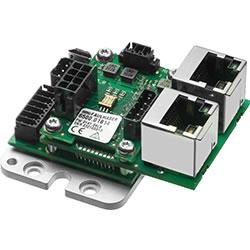With over 25 years of experience advising mid-market companies, Ghori provides a grounded yet progressive-looking take on where manufacturers should focus, what misconceptions to avoid, and how to get started without overhauling everything.
Common Misconceptions Manufacturers have about AI
Q&A with Ghazanfar Ghori is President and CTO | Enterprise64
Artificial Intelligence is no longer a futuristic idea for manufacturers; it’s real and penetrating the industry, helping businesses improve efficiency and uptime.
In this interview, Ghazanfar Ghori, President and CTO at Enterprise64, shares his perspective on how AI, particularly Edge and Agentic AI, is reshaping the manufacturing industry.
With over 25 years of experience advising mid-market companies, Ghori provides a grounded yet progressive-looking take on where manufacturers should focus, what misconceptions to avoid, and how to get started without overhauling everything.
Tell us about yourself and your role with Enterprise64.
I’m the President and CTO at Enterprise64, where I help mid-market companies align technology with business goals and outcomes. This includes scaling operations, modernizing legacy systems, and building the technical foundations needed for growth. A key part of my work is advising leadership teams on how to invest in AI and Cloud in ways that go beyond infrastructure, and lead to real, measurable impact.
With over 25 years of experience, I’ve led senior engineering and product teams across a range of industries and complex environments. My background in Computer Science and Chemical Engineering has given me a strong foundation in both deep technical thinking and practical execution, which is at the heart of how we partner with clients at Enterprise64.
How do you see AI transforming the manufacturing industry in the next 3–5 years?
AI is already delivering value in manufacturing. It’s reducing downtime, improving process control, and enabling faster decision-making. But the next leap won’t come from predictive dashboards or cloud analytics. It’ll come from two places: Edge AI and Agentic AI.
Edge AI moves intelligence closer to the machines. Decisions happen locally, in real time, without waiting on cloud roundtrips. We’re seeing it used in quality control, energy optimization, and predictive maintenance. We’ve worked with teams deploying computer vision models directly on the line to catch defects immediately, not minutes or hours later. That’s less scrap, faster throughput, and fewer disruptions.
Then there’s Agentic AI, which is still emerging but extremely promising. These are systems that observe, reason, decide, and act within defined guardrails. Imagine an agent that spots a spike in demand, reprioritizes production, triggers procurement, and updates delivery timelines... all without a human in the loop. Gen AI will have a role too but it’s mostly supportive. The real operational wins will come from Edge and Agentic AI enabling systems that adapt in real time, reduce reliance on manual intervention, and make supply chains more secure and resilient.
What are some common misconceptions manufacturers have about AI that you’d like to address?
A big one is the belief that AI is only for large, high-tech manufacturers, not for the mid-sized, traditional plants. That’s simply not true. We’ve seen Edge AI deployed on shop floors to detect defects, optimize energy use, or predict equipment failure, without massive infrastructure overhauls. You really don’t need moonshot budgets or a data science team. You need clarity on where waste happens, and what’s worth fixing with automation.
Another common fear is around data, that unless everything is clean, structured, and centralized, AI isn’t possible. The reality is, no manufacturer has perfect data. But that shouldn’t be a blocker. You start by measuring what matters. Focus on one process, capture the right signals, and prove value. That’s how you build confidence and internal momentum.
Lastly, too many leaders still treat AI like a bolt-on — something the IT team handles. That’s a mistake. AI is a strategic lever. It impacts uptime, yield, cost-to-serve, and supply chain agility. But it only works if it’s aligned with how the business operates. If your data’s siloed, your processes are inconsistent, or there’s no clear accountability, AI won’t help. It will just expose those gaps faster.
Which areas of manufacturing do you think offer the greatest potential for AI-driven optimization (e.g., predictive maintenance, quality control, supply chain)?
Right now, the biggest wins are coming from three places: predictive maintenance, quality control, and AI-driven supply chain planning.
Predictive maintenance is one of the most proven use cases. Companies have reduced unplanned downtime by up to 30% just by layering machine learning onto sensor data. It’s the kind of shift that saves millions annually in parts and lost production time.
Quality control is another high-impact area, especially with Edge AI. Instead of doing inspections post-production, companies are deploying computer vision models right on the line. BMW, for instance, is using AI-powered image recognition to flag defects in real time, leading to measurable reductions in scrap and rework.
Then there’s supply chain and production scheduling, where Agentic AI is starting to play a real role. These systems aren’t just flagging issues; they’re taking action. When demand shifts or raw material delays hit, they adjust production plans and rebalance priorities without waiting on human input. That’s a massive unlock for manufacturers who’ve been operating on outdated ERPs and disconnected systems for years.
If you're looking for fast ROI, predictive maintenance and quality control are safe bets. But if you're aiming to compete on speed, margin, and resilience, tying those improvements into supply chain operations with agentic systems is where the game truly changes.
How important is data in AI adoption for manufacturers, and what should companies do to prepare?
Yes, data is important for AI, but it doesn’t need to be perfect. Often companies focus on more data instead of useful data. Start with one process, instrument it properly, and make sure you trust the signals.
Clean, structured, and connected data is what separates AI that actually delivers from AI that demos well. If your systems don’t talk to each other and your data’s a mess, fix that first. Otherwise, AI will just expose your chaos faster.
What advice would you give to manufacturing leaders who want to begin their AI journey but don’t know where to start?
Don’t start with AI. Start with the problem that’s hurting your line the most. If you’re chasing AI without a clear outcome in mind, you’ll burn budget fast and get nowhere.
Pick one area where you're bleeding time, money, or consistency. It could be unplanned downtime, scrap rates, or scheduling chaos. Measure it, understand the process behind it, and explore where smart automation could make a dent. You don’t need a full roadmap on day one. You need a clear first win.
Also, don’t do it alone. The right tech partner will help you move fast without making rookie mistakes, such as automating noise or chasing the wrong data. You know your operations. The right partner will help you turn that knowledge into a system that delivers and creates impact.
Conclusion
As AI continues to evolve, its actual impact in manufacturing will come from practical, focused use cases that solve real problems on the ground.
Ghazanfar’s insights offer a roadmap for leaders who want to leave behind the buzzwords, strengthen their supply chains, improve operational quality, and bring measurable change to their business.
Ghazanfar Ghori is President and CTO at Enterprise64. He advises mid-market leaders on how to use technology to scale, modernize, and drive real ROI. His work blends 25+ years of technical depth with business-first execution.
The content & opinions in this article are the author’s and do not necessarily represent the views of ManufacturingTomorrow
Featured Product


